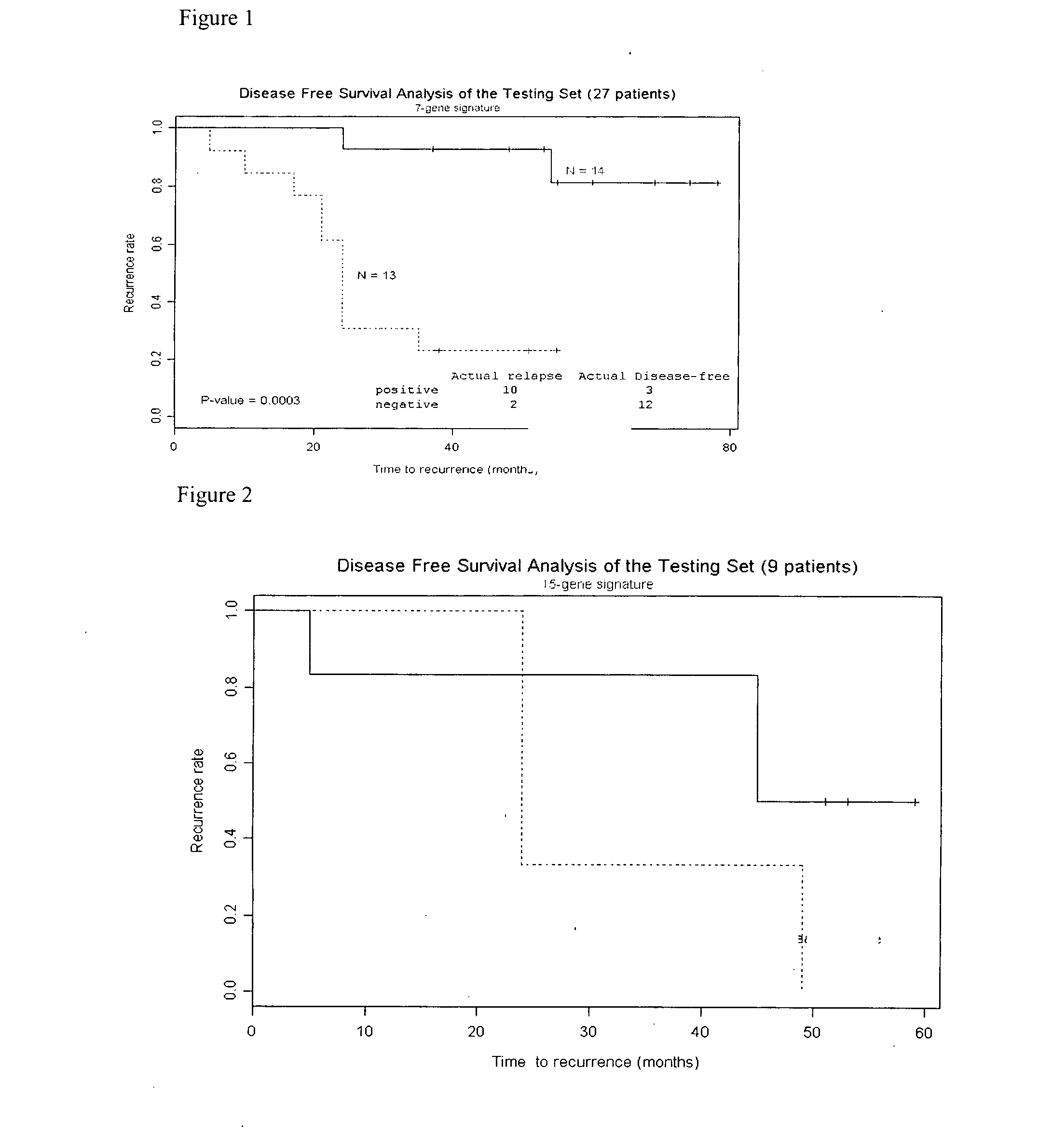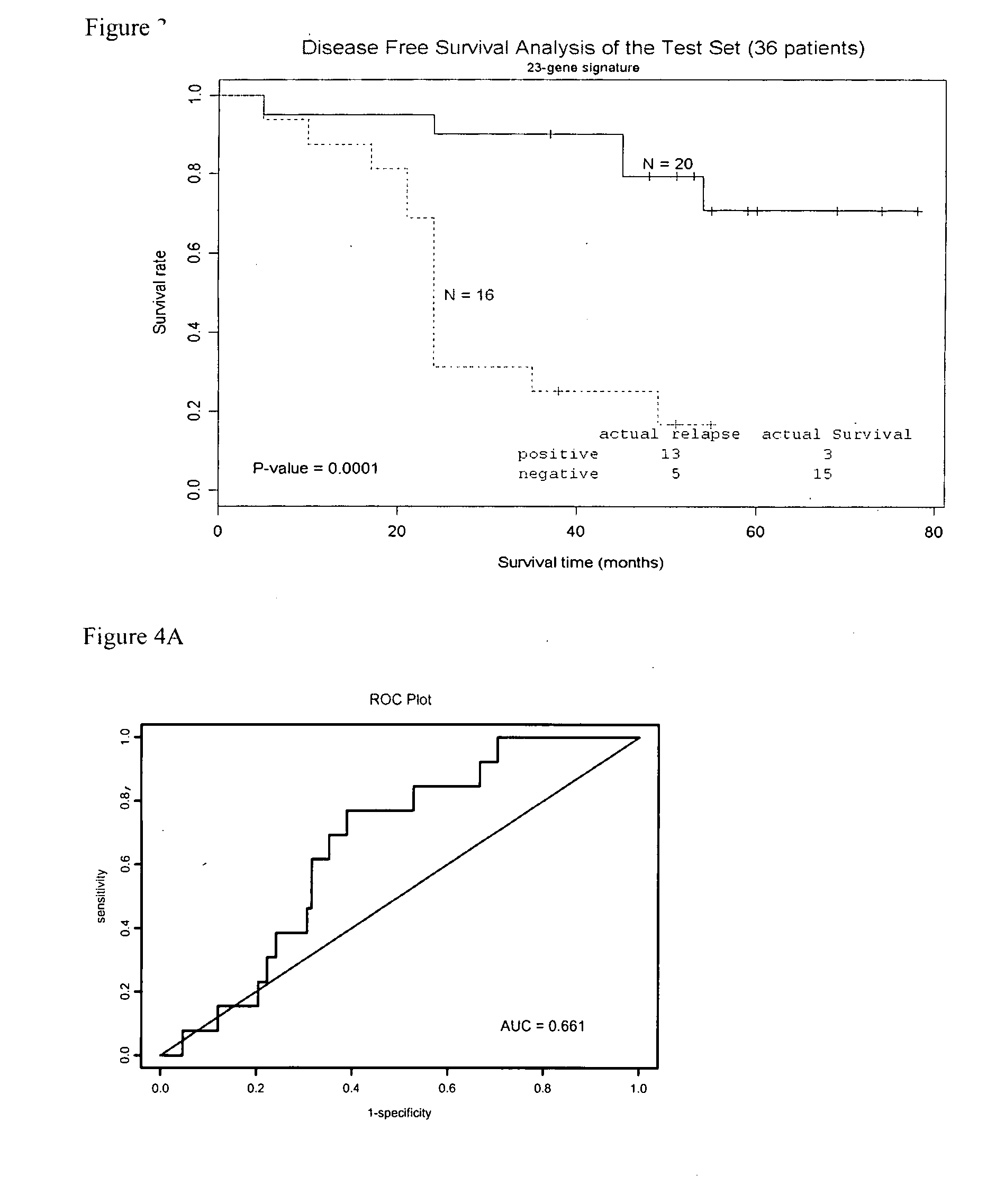Molecular assay to predict recurrence of Duke's B colon cancer
a molecular assay and colon cancer technology, applied in the field of colorectal cancer prognosis, can solve the problems of difficult detection and controversy of post-operative chemotherapy benefits of duke's b, and the classification of duke's b is imperfect, and the assay requires fresh frozen tissue samples
- Summary
- Abstract
- Description
- Claims
- Application Information
AI Technical Summary
Problems solved by technology
Method used
Image
Examples
example 1
Sample Handling and LCM.
[0064] Fresh frozen tissue samples were collected from patients who had surgery for colorectal tumors. The samples that were used were from 63 patients staged with Duke's B according to standard clinical diagnostics and pathology. Clinical outcome of the patients was known. Thirty-six of the patients have remained disease-free for more than 3 years while 27 patients had tumor relapse within 3 years.
[0065] The tissues were snap frozen in liquid nitrogen within 20-30 minutes of harvesting, and stored at −80 C° thereafter. For laser capture, the samples were cut (6 μm), and one section was mounted on a glass slide, and the second on film (P.A.L.M.), which had been fixed onto a glass slide (Micro Slides Colorfrost, VWR Scientific, Media, Pa.). The section mounted on a glass slide was after fixed in cold acetone, and stained with Mayer's Haematoxylin (Sigma, St. Louis, Mo.). A pathologist analyzed the samples for diagnosis and grade. The clinical stage was esti...
example 2
RNA Extraction and Amplification.
[0068] Zymo-Spin Column (Zymo Research, Orange, Calif. 92867) was used to extract total RNA from the LCM captured samples. About 2 ng of total RNA was resuspended in 10 μl of water and 2 rounds of the T7 RNA polymerase based amplification were performed to yield about 50 Vg of amplified RNA.
example 3
DNA Microarray Hybridization and Quantitation.
[0069] A set of DNA microarrays consisting of approximately 23,000 human DNA clones was used to test the samples by use of the human U133a chip obtained and commercially available from Affymetrix, Inc. Total RNA obtained and prepared as outlined above and applied to the chips and analyzed by Agilent BioAnalyzer according to the manufacturer's protocol. All 63 samples passed the quality control standards and the data were used for marker selection.
[0070] Chip intensity data was analyzed using MAS Version 5.0 software commercially available from Affymetrix, Inc. (“MAS 5.0”). An unsupervised analysis was used to identify two genes that distinguish patients that would relapse from those who would not as follows.
[0071] The chip intensity data obtained as described was the input for the unsupervised clustering software commercially available as PARTEK version 5.1 software. This unsupervised clustering algorithm identified a group of 20 pat...
PUM
| Property | Measurement | Unit |
|---|---|---|
| pH | aaaaa | aaaaa |
| pH | aaaaa | aaaaa |
| size | aaaaa | aaaaa |
Abstract
Description
Claims
Application Information
 Login to View More
Login to View More - R&D
- Intellectual Property
- Life Sciences
- Materials
- Tech Scout
- Unparalleled Data Quality
- Higher Quality Content
- 60% Fewer Hallucinations
Browse by: Latest US Patents, China's latest patents, Technical Efficacy Thesaurus, Application Domain, Technology Topic, Popular Technical Reports.
© 2025 PatSnap. All rights reserved.Legal|Privacy policy|Modern Slavery Act Transparency Statement|Sitemap|About US| Contact US: help@patsnap.com



